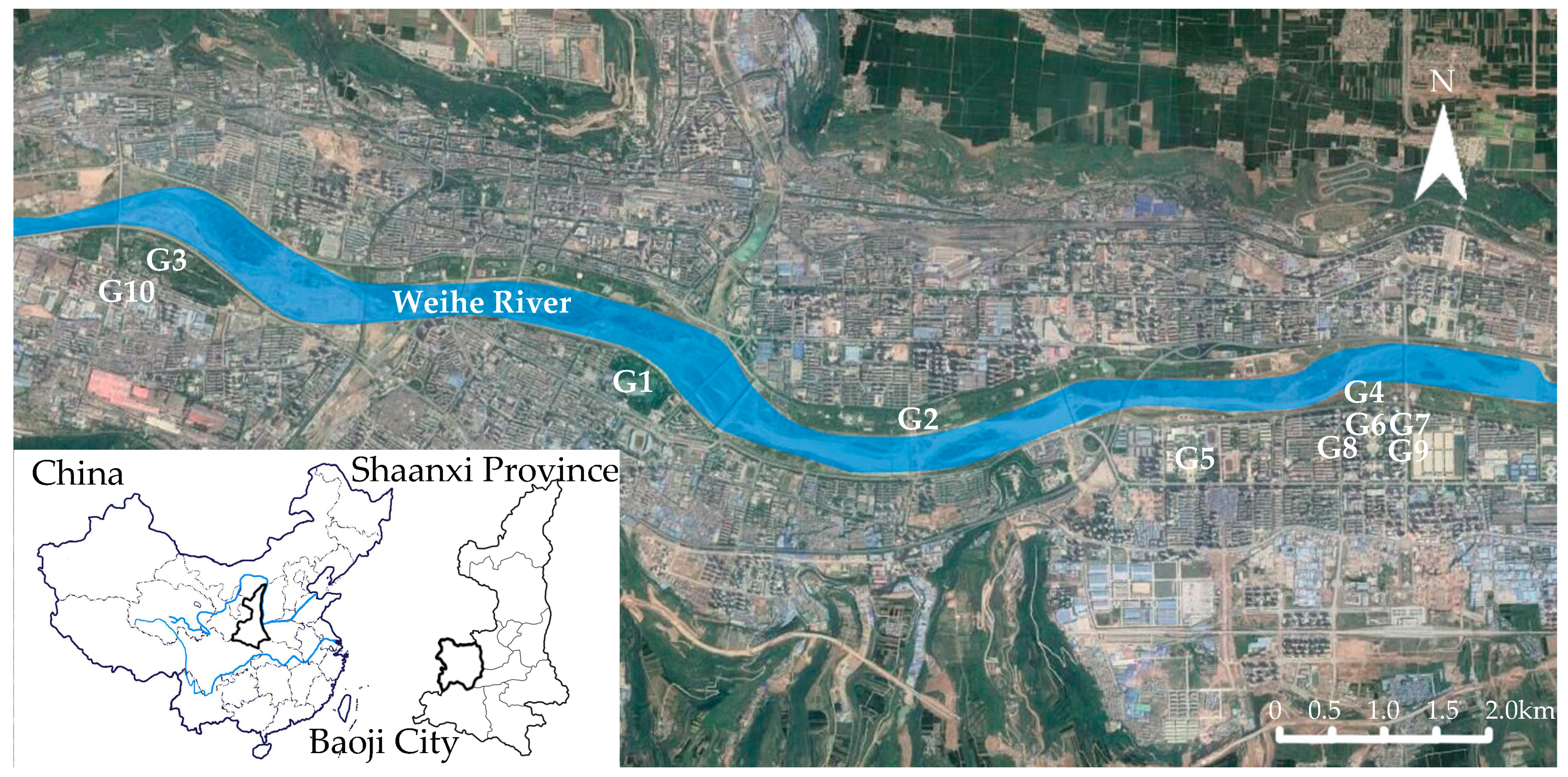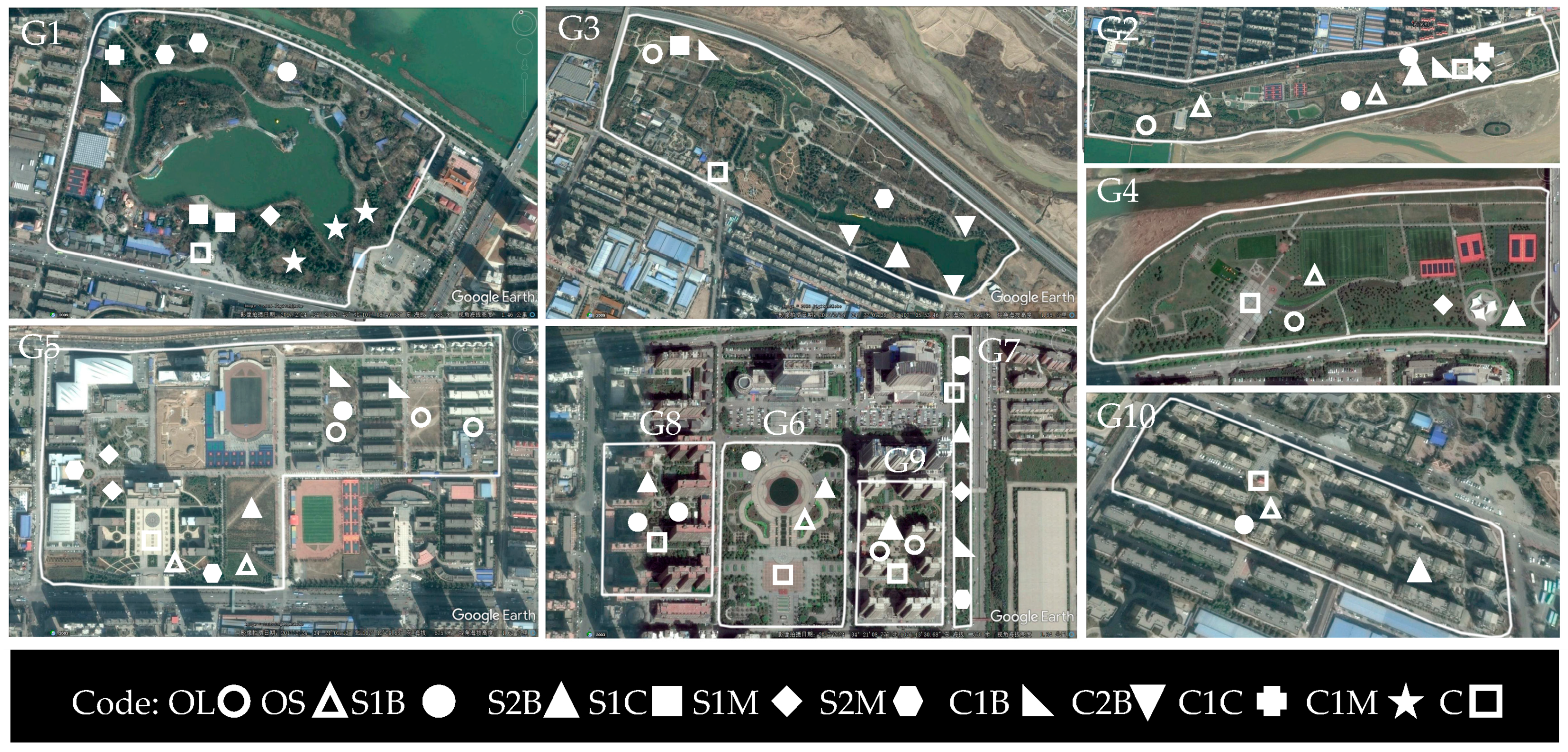4.1. Effects of Environmental Factors on PM Concentration
All the study plots and their repetitions in this study were distributed evenly in ten study areas to reduce the interference caused by different environmental conditions in different study areas and their surroundings. In addition, they were located in the city, with similar surrounding environments and no obvious sources of pollutants and were a long distance from motorways; nevertheless, it was still found that the location had a highly significant impact on the airborne particulate concentrations. The concentration of PM2.5 and PM10 in the People’s Park (G1), Botanical Garden (G3) and Jufeng Botanical Garden Ecological Community (G10), which was close to the botanical garden, were the lowest, because the conservation and management of green spaces in these areas was high, ensuring that the plants were regularly trimmed, watered and fertilised. This result was consistent with a previous study which showed that the level of plant management has a certain impact on its ability of reducing air particles [
34]. The higher the degree of plant management, the greater the ability to reduce airborne particulate matter. Through regular pruning and watering, the particles would be removed from the plants’ surface restoring their ability for dust retention. Since the traffic flow around the High-tech Square (G6) and affiliated green space of Panlong Bridge (G7) is higher than other locations, the PM2.5 and PM10 concentrations are higher, due to vehicle exhaust emissions. Leonard et al. [
14] showed that vehicle exhaust emissions have a significant impact on airborne particulate concentrations, and tight control of relevant measures can effectively reduce airborne particulate concentrations [
35].
This study found that the time of monitoring had a highly significant effect on the concentration of airborne particulates, which could be attributed to the interaction between the surrounding pollution sources and the changes in meteorological factors during the day [
19,
26]. The concentration of airborne particles during the day showed a slight increase after a decreasing trend. It was high in the morning, declined in the afternoon, and gradually rose in the evening; the lowest value of PM10 concentration was found between 12 a.m. and 2 p.m., while the minimum PM2.5 concentration was between 2 p.m. and 4 p.m. Huge traffic flow, a large number of automobile exhaust emissions, and serious dust may cause airborne particulate matter concentration to increase in the morning and to reach its peak in the evening. At noon, airborne particulate concentration was low due to there being fewer people and less traffic flow and lighter pollution. Atmospheric particulate matter concentration could be positively correlated with pedestrian flow and traffic flow [
36,
37].
To avoid the great influence of dramatic changes in meteorological factors on the concentration of airborne particulates, the days with sunny and breeze weather conditions were selected for test. However, the results still showed that meteorological factors had a highly significant effect on the concentration of PM2.5 and PM10, and their concentrations increased with wind velocity and humidity, and decreased with temperature. In the same weather conditions, the PM10 concentration range was greater than the range of PM2.5 concentration, which could indicate that the larger the particle size of the particles, the more easily transported or settled, and the more obvious the response to meteorological factors [
26,
37,
38].
Wind velocity affects airflow and the diffusion of airborne particulates. Freer-Smith et al. [
39] found that the particulate matter sedimentation rate under gale conditions (9 m·s
−1) was higher than under breeze conditions (3 m·s
−1). Beckett et al. [
40] found that when the wind velocity was less than 8 m·s
−1, the particulate matter sedimentation rates increased with the increase of wind velocity, but the increase of wind velocity may lead to a decrease in the particulate matter sedimentation rate. Wang et al. [
27] showed that the concentration of airborne particles increased first and then decreased with the increase of wind velocity, and reached its peak at a maximum wind speed of 14 m/s. Wind speed significantly influenced particulate matter capture efficiency of plants, and particulate matter leaf deposition was positively correlated with low wind speed, but it may decrease with wind speed above a certain critical range [
39,
40]. The resuspension and deposition rates both varied with different sizes even if the wind speed was similar [
41], i.e., large particles and coarse particulates were easily blown off, while fine particulate matter distributed in the grooves of leaf surface was not readily blown away [
27,
42]. That is, in this study, under breeze conditions, the wind velocity in the range of 3 m·s
−1 was too small to sufficiently diffuse the air particles, resulting in an increase in the concentration. In addition, the wind direction also has a certain influence on the diffusion of air particles. The wind speed studied in this study was low, so this direction was not explored in detail. In future research, wind direction can be increased, especially in the study of airborne particles in traffic-crowded streets.
With the increase of temperature, the convective effect of the atmosphere in the vertical direction was more frequent. This gas circulation exchange accelerated the transportation of air particles, helping reduce the concentration of air particles. Furthermore, with the temperature increased, plant photosynthesis and adsorption of particulate matter were strengthened, helping adsorb airborne particles [
26,
43,
44].
Within a certain range, fine particles were more easily condensed as coagulation nuclei as the humidity increased, resulting in an increase in air particulate concentration. When the relative humidity increased to a certain extent, the amount of wet deposition increased, and then the particle concentration decreased [
26,
28]. Additionally, an increase in wettability and relative humidity can trigger certain emission mechanisms of biological particles, such as the active wet ejection of fungal spores or hygroscopic swelling-induced pollen fragmentation, increasing the concentration of atmosphere biological particles around vegetation [
45].
In this study, the changes of green space area between 0.01 and 1.65 ha had no significant influence on the concentration of PM2.5 or PM10. There were also no significant differences between green spaces and control groups.
That is, the reducing effect on atmospheric particulate matter concentration by green spaces compared to gray spaces was very limited at this area of scale. Green space area was one of the factors that affected the ability of particulate matter dust retention. Within a certain range, the larger the area is, the better the reduction of particulate matter concentration in green space. Liu et al. [
46] found that PM2.5 concentration index was negatively correlated with forest area. Similarly, the concentration of PM10 in the air was also largely influenced by the green space area factor, increasing the green space area helps to reduce the PM10 concentration in the air [
47]. Previous studies have shown that the larger the area of green space, such as forests and parks in the city, the greater the reduction in airborne particulates [
48]. Urban areas with proportionally higher concentrations of urban forestry may experience better air quality with regard to reduced ambient particulate matter [
24]. In urban land use and land cover planning, increasing the coverage of green land can effectively reduce the concentration of air pollutants [
49,
50]. All the plots involved in this study were less than 2 ha, and our results confirmed the former. The reduction of particulate matter concentration in the air at this area of scale was not significant, so there was no significant difference in particulate matter dust retention capacity. However, determining the critical value of green area that could reduce the concentration of airborne particulates should be the focus further study. In this study, in which the area of green space was no more than 2 ha, the change in area was not sufficient to produce qualitative changes in the concentration of particulate matter in the air. This would be an important implication for the purposes of eco-oriented design of green space planning and design, in that the configuration of different plants at such a small scale could be very limited in terms of purifying the air particulate matter.
4.2. Effects of Vegetation Structural Factors on PM Concentration
There was no significant difference in the reduction of PM2.5 concentration in different vegetation structures in green spaces, while there were significant differences in PM10 concentration. Plants use their special micro-morphological structure to retain particulate matter. The ratio of the mass and volume of PM10 on the leaf surface was much larger than that of PM2.5 [
51]; that is, the plant had a stronger reduction effect on the larger particle size, which may cause this difference.
The concentration of PM10 in the open green spaces dominated, with lawns and shrubs being the lowest, while that of double-layered closed broad-leaved forests was the highest. Therefore, green spaces with different vegetation structures can be scientifically chosen for adsorption of particulate matter concentration in air quality-oriented green space planning and design. Some researchers have considered that the concentration of airborne particulate matter in the closed plant communities is higher than that in open plant communities [
21,
52]. Particulate matter leaf depositions on trees and shrubs with complex structures are higher than those of herbs and liana species [
53]. Through the analysis of the vegetation characteristics of different vegetation structures, we found that in double-layered closed broad-leaved forest the structure of the vegetation was complex, causing air turbulence, and the plant species were diverse and varied in quantity, hindering the sedimentation of PM10 [
42]. The particles adsorbed on the surface of the broadleaf leaves were only temporarily trapped, prone to bounce back, and were then suspended in the atmosphere, thereby increasing the concentration of air particles [
54,
55]. In the open green spaces dominated by lawns and shrubs, the sedimentation of PM10 was less obstructed, and the settling process could be completed directly; therefore, the concentration of PM10 in the air was low. Another possible reason was that meteorological factors, especially wind, have a greater influence on the concentration of particulate matter in open vegetation structures, and it was possible to transport the pollutant to a new location, reducing the concentration.
In addition to considering the impact of vegetation structure on airborne particulate matter, tree species therein also have a significant impact on air quality. Trees are a source of air pollutants, and they can produce pollen, spores, some bio-volatile organic compounds, and other biological particles, and increase the concentration of air particles after the chemical reaction with other pollutants in the air and the formation of organic aerosols [
56,
57,
58]. In addition, the particles produced by the plant itself could limit the spread of contaminants and thus increase the concentration of local particulates [
59,
60]. Therefore, it could also be one of the reasons for increasing the concentration of particulate matter that the large number of plants and their complex layers in double-layered closed broad-leaved forests. In future studies, it is necessary to carry out more detailed classification and to examine whether the difference of specific plant species is significant for the reduction of airborne particle concentration.










